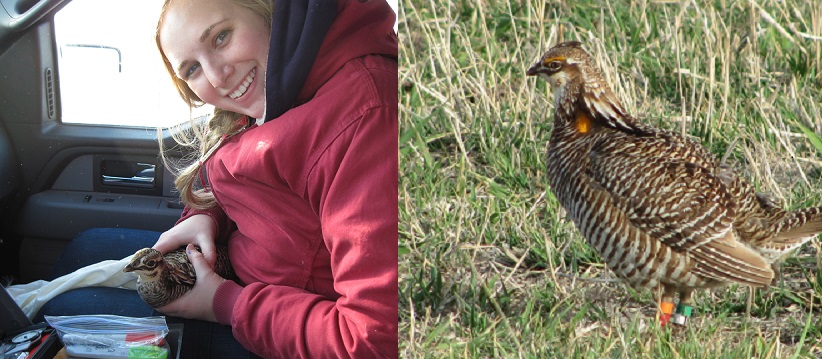
While humans have long pondered why chickens cross the road, one prairie chicken has University of Nebraska-Lincoln researchers looking beyond the punch lines.
What they're learning is expanding knowledge about the habitat and conservation needs of this once abundant native species whose numbers and range have dwindled.
Jocelyn Olney, a natural resources graduate student, is part of a UNL School of Natural Resources research team that banded 70 prairie chickens living within about 15 miles (25 kilometers) of a wind farm near Ainsworth, Neb ., in Nebraska's Sandhills. Researchers banded the birds in April 2013 and are tracking them to learn whether the wind farm influences their movements.
"Nebraska has large numbers of prairie chickens and their population is fairly stable," said Larkin Powell, professor of natural resources, director of the Great Plains Cooperative Ecosystems Studies Unit and Olney's adviser. "But in Iowa, Illinois, Missouri, Minnesota and Wisconsin, prairie chickens have disappeared from much of their native range. That makes Nebraska birds even more important, and it makes it very important for us to make sure that we manage that population well."
Last fall, a hunter recovered one bird more than 30 miles from its lek grounds — areas where the birds gather for spring mating — where researchers conducted the trapping/banding/release. While that kind of movement is not unusual for a human, it's intriguing for a bird that normally stays within five miles of lek grounds during breeding, nesting and brood-rearing seasons.
The movement of prairie chickens relates to how populations can be managed and, ultimately, nurtured for future generations.
"A simple question is: how much land do we need to manage for a group of prairie chickens?" Powell said. "It turns out that they use a lot of space and their space use changes with the season. It is important for us to think about their entire life cycle. If one part of that cycle is missing, the population will be affected."
Olney and other UNL researchers are now looking into what drew this one prairie chicken so far away from its lek.
"Prairie chickens are not a typical migratory bird, but they may need to migrate within their region to find winter food," Olney said. "Traveling long distances is a trade-off for them — they have to spend energy to find a source of dependable energy."
Each of the birds trapped were outfitted with a unique combination of bands that allow for easy identification from a distance. The females were also outfitted with either a very-high frequency (VHF) radio transmitter collar or a rump-mounted satellite tag.
The ID bands are important because if a prairie chicken is predated or hunted, researchers can identify the individual bird. Data collected through the band identifications helps assess how far the birds travel and whether the movements are influenced by the wind farm.
The well-traveled prairie chicken was tagged with a VHF radio collar. However, researchers never found her during the spring or summer breeding, nesting and brood-rearing seasons, which may indicate that she traveled the distance during the spring or summer.
"Ranchers may think that their birds remain on or near their ranch all year," Powell said. "It turns out the birds' year is more complicated, and they use habitat throughout the local region."
Since the initial hunter report, Olney and Jen Smith, a postdoctoral research associate in the School of Natural Resources, have confirmed similar movements from other VHF- and satellite-tagged birds. Smith located six VHF birds in January using an airplane. Olney and Smith have started to assess the detailed daily movements of three satellite-tagged birds.
Olney said the birds — which can fly only for short periods close to the ground — made most of their journey during the fall by moving a few miles in staggered fashion until they had completed the journey.
"After seeing this pattern, our team hypothesized that perhaps prairie chickens are simply not built for traveling longer distances quickly," Olney said.
However, Smith recently reported to the team that two of the satellite-tagged birds moved 15 miles back to the breeding grounds in a single day.
"Pretty impressive," Smith said.
So, Olney is back to thinking about the summer movements of prairie chickens and their broods in the context of the large fall and spring movements that appear to be commonplace in this region.
"It's quite a journey," Olney said.
Prairie chickens were historically found across 20 states and four Canadian provinces. However, grassland conversion to agriculture and subsequent habitat loss over the past 80 years have significantly reduced their range. Nebraska has one of the largest populations of greater prairie chickens in the United States.
Research led by Powell, avian biologists Mary Bomberger Brown and Smith, rangeland ecologist Walter Schacht and students continues to broaden knowledge on the nesting and brood-rearing habitat needs of the birds.
— Mekita Rivas, Natural Resources